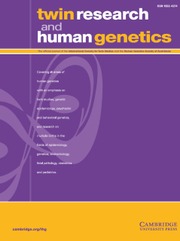Article contents
Multiple Regression Analysis of Reading Performance Data from TwinPairs with Reading Difficulties and Nontwin Siblings: The Augmented Model
Published online by Cambridge University Press: 28 March 2012
Abstract
The augmented multiple regression model for the analysis of data from selectedtwin pairs was extended to facilitate analyses of data from twin pairs andnontwin siblings. Fitting this extended model to data from both selected twinpairs and siblings yields direct estimates of heritability (h2) andthe difference between environmental influences shared by members of twin pairsand those of sib or twin–sib pairs (i.e., c2(t)– c2 (s)). When this model was fitted to readingperformance data from 293 monozygotic and 436 dizygotic pairs selected forreading difficulties, and 291 of their nontwin siblings, h2 = .48± .22, p = .03, and c2 (t) –c2 (s) = .22 ± .12, p = .06. Although the testfor differential shared environmental influences is only marginally significant,the results of this analysis suggest that environmental influences on readingperformance that are shared by members of twin pairs (.36) may be substantiallygreater than those for less contemporaneous twin–sibling pairs(.14).
Information
- Type
- Articles
- Information
- Twin Research and Human Genetics , Volume 15 , Issue 1: Special Section: The Intersection of Behavioral Genetics and PoliticalScience , February 2012 , pp. 116 - 119
- Copyright
- Copyright © Cambridge University Press 2012
- 1
- Cited by

